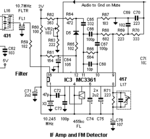analog_curious
Member level 2
Hi all,
I would like to know whether there is any application requiring AM Mixer. From what I learnt about AM Receivers, there is no necessity to shift the RF signal to any IF level as the modulation basically depends on the amplitude modulation and its carried out by the envelope detector stages. In that case, why would people design AM Mixers ?
Any suggestions please..
(Or they use it only in the AM Transmitters to do the upconversion ?? )
Dan
I would like to know whether there is any application requiring AM Mixer. From what I learnt about AM Receivers, there is no necessity to shift the RF signal to any IF level as the modulation basically depends on the amplitude modulation and its carried out by the envelope detector stages. In that case, why would people design AM Mixers ?
Any suggestions please..
(Or they use it only in the AM Transmitters to do the upconversion ?? )
Dan
